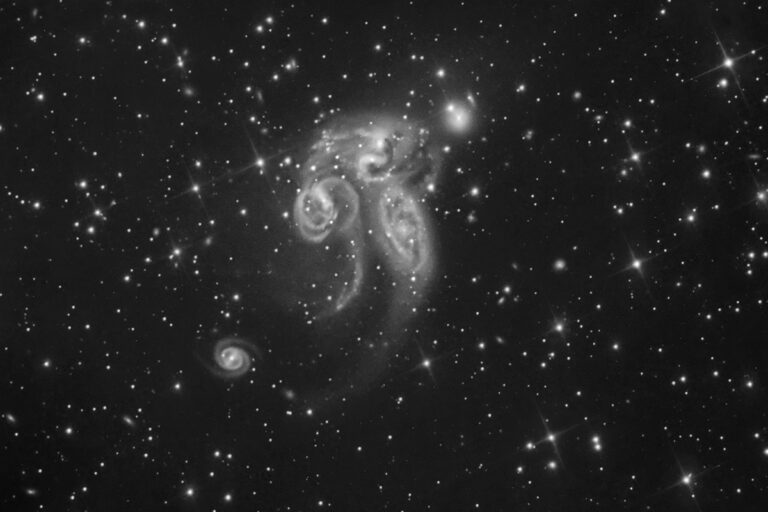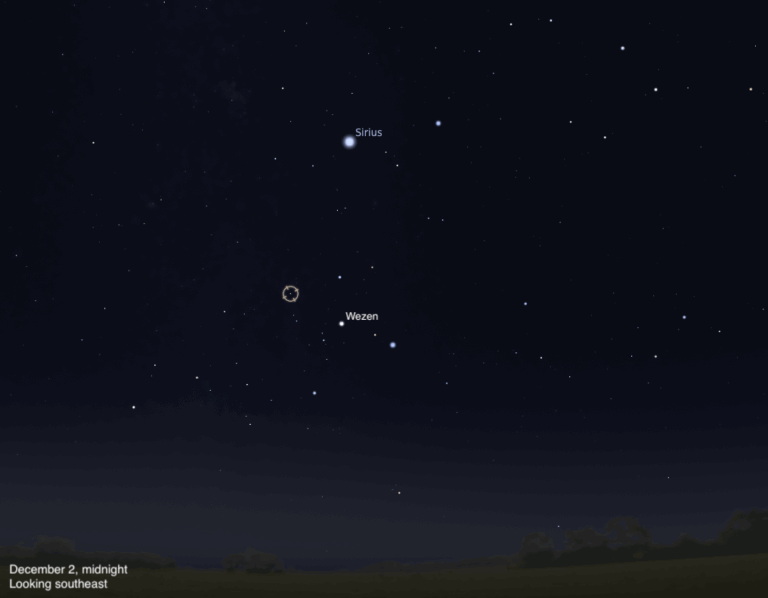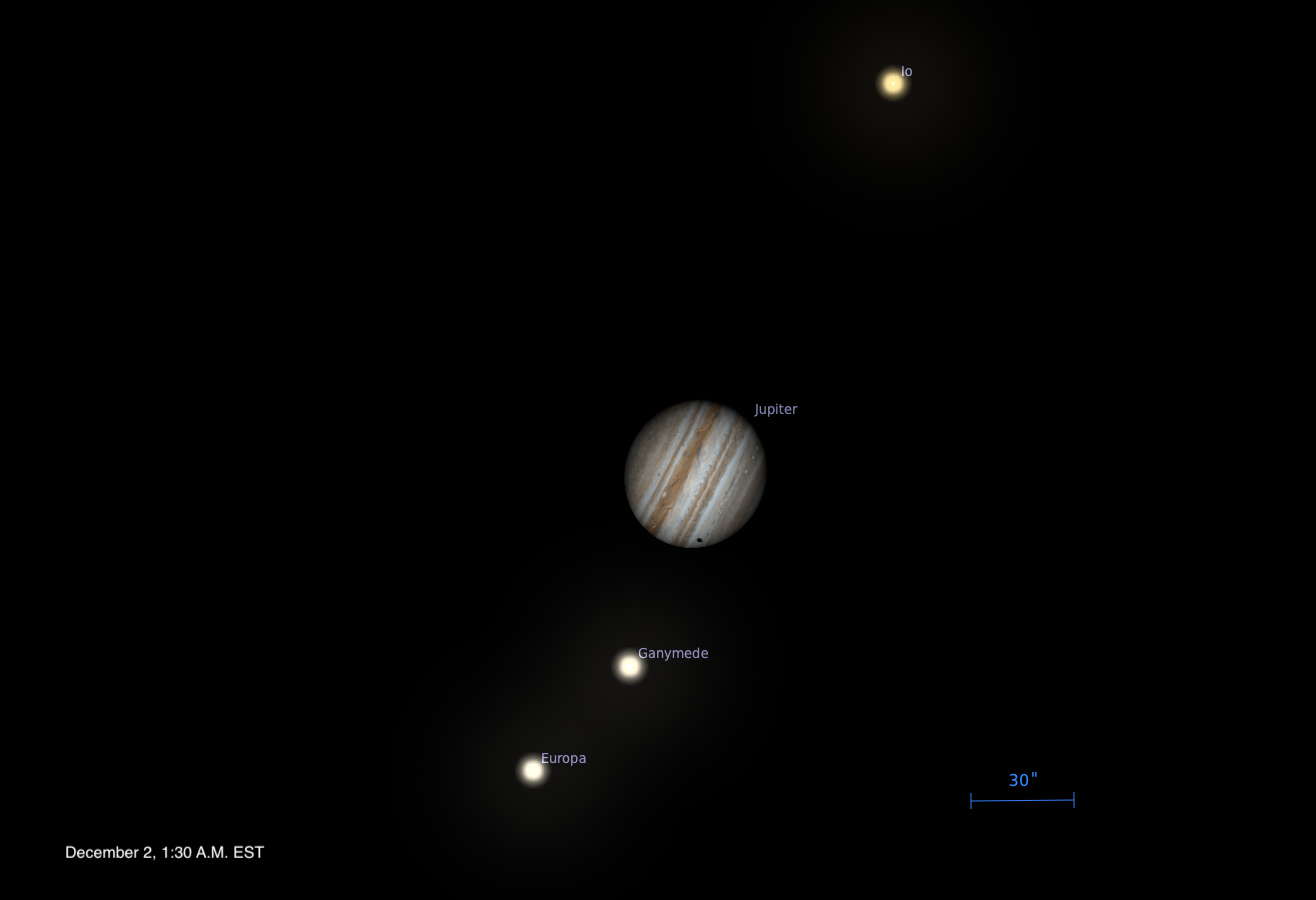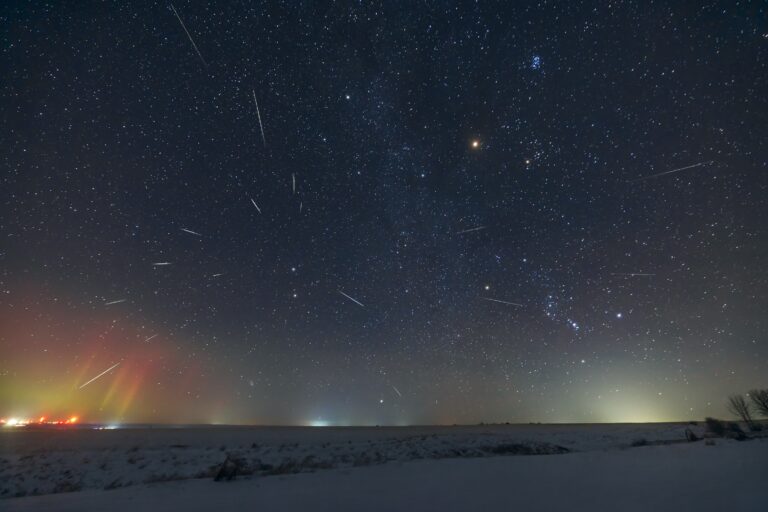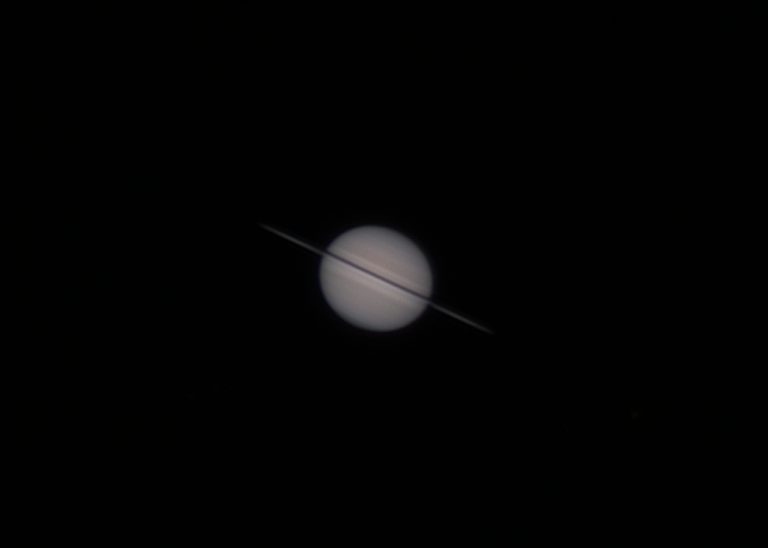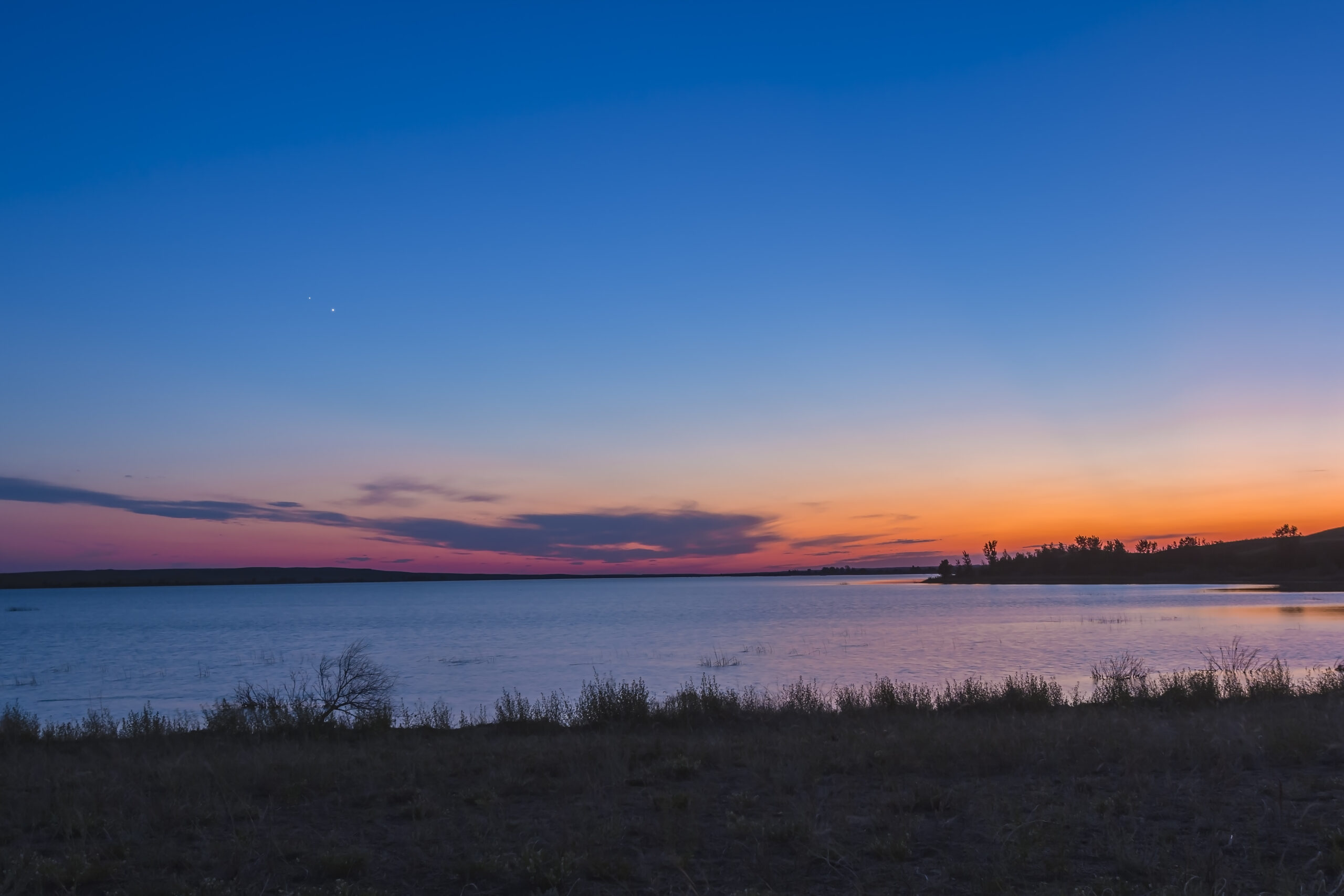
Key Takeaways:
- August 2025 offers several planetary conjunctions, including a close approach of Venus and Jupiter on August 12th, and a second conjunction of Saturn and Neptune on August 6th, with a third occurring in February 2026.
- Observations of Mars in southwestern Virgo are detailed, noting its proximity to specific stars (Beta Virginis, Porrima, and Spica) throughout the month, although telescopic detail remains limited.
- Two shadow transits of Titan across Saturn's disk are predicted for August 3rd and August 19th, observable with telescopes, along with transits of Enceladus and Tethys on August 3rd. Saturn's rings are favorably tilted for observation.
- The Perseid meteor shower peaks on August 12th, though the Full Moon will impact visibility, and observations of Uranus, Mercury, and comet C/2024 E1 (Wierzchoś) are discussed with varying levels of accessibility based on magnitude and required equipment.
The longer nights of August beckon with several treats this month. Saturn and Neptune undergo their second conjunction of the year, appearing together in a low-power telescope eyepiece. Telescopic observers also get two shadow transits of Titan across Saturn. Early risers enjoy a spectacular conjunction of the two brightest planets in the sky, Venus and Jupiter, on Aug. 12, the same day the Perseid meteor shower peaks.
Mars glows at magnitude 1.6, low in the western sky after sunset. Throughout August it travels across southwestern Virgo. On Aug. 2, the Red Planet stands 8′ southeast of 4th-magnitude Beta (β) Virginis. Look for the pair 10° high in the western sky an hour after sunset.
Mars then moves to sit 2.7° south of Porrima (Gamma [γ] Virginis) on the 24th. On that date, Mars is also 13° to the lower right of 1st-magnitude Spica, Virgo’s brightest star.
A fine crescent Moon is visible soon after sunset on the 25th, with Mars 7° to its upper left (east). The next evening, the Moon, Mars, and Spica form a skewed triangle, with Spica 7° east of the Moon.
Through a telescope, it is difficult to see any detail on the small, 5″-wide martian disk. While Mars remains visible in the evening sky for months, the telescopic view doesn’t improve.
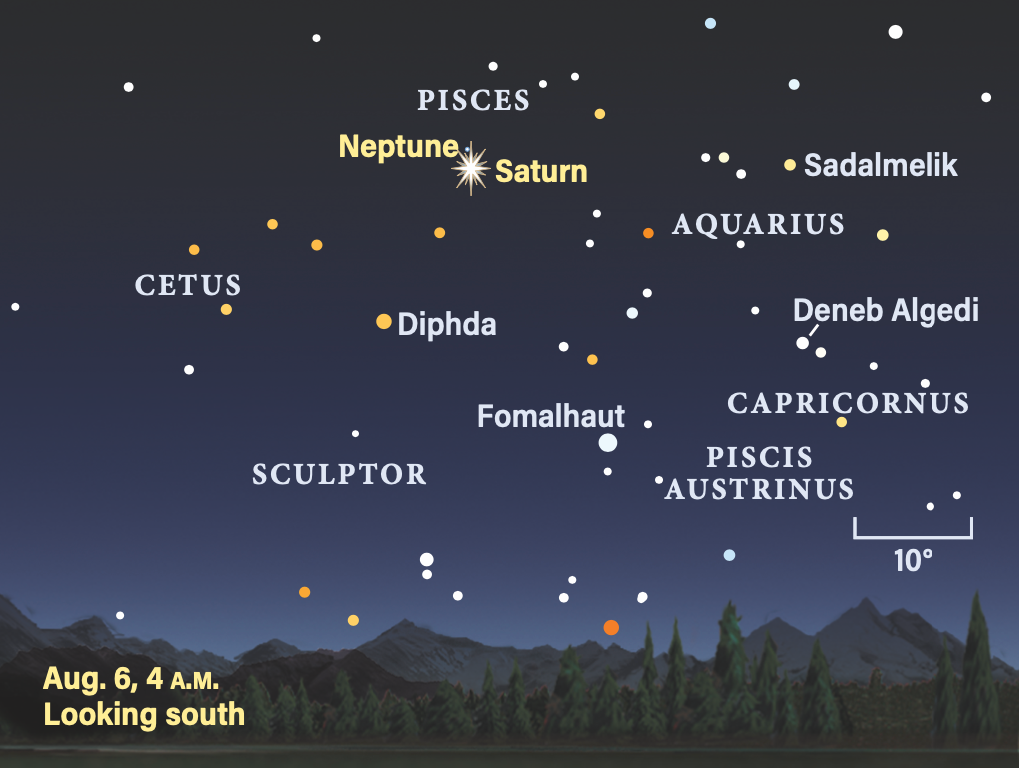
Saturn and Neptune rise together around 10:30 p.m. local daylight time on Aug. 1. Saturn starts the month at magnitude 0.8 and is an easy object low in the eastern sky an hour after it rises. Both planets lie in western Pisces, southeast of the Circlet.
Neptune and Saturn undergo the second of three conjunctions within the span of a year. The first occurred at the end of June; this month, they are 1.1° apart on Aug. 6. A third conjunction occurs Feb. 15, 2026, when they are 0.9° apart.
Neptune is magnitude 7.7, within reach of binoculars. It is fairly obvious due north of Saturn in a low-power eyepiece in a telescope.
Viewing both planets together is rare. Consider that Neptune lies 1.9 billion miles beyond Saturn! Saturn’s disk appears 19″ across, while bluish Neptune spans a mere 2″.
We have a fine view of the southern face of Saturn’s rings for the first time in over 15 years. The rings are tilted 3° to our line of sight. With the narrow rings, it’s a good time to watch for any unusual bright cloud features on Saturn’s disk.
Our Moon passes close by overnight on Aug. 11/12. Soon before sunrise on the 12th, Saturn stands 3.5° southeast of Moon, while Neptune is 1.2° north of Saturn.
Titan, Saturn’s largest moon, shines at magnitude 8.5. It’s an easy object to spot in small telescopes. Due to the current tilt of its orbit, Titan’s shadow transits Saturn’s disk, with repeat events over the next few months.
The first event is lined up nicely for the U.S. and Canada. Titan’s shadow begins a transit Aug. 3 at 2:04 a.m. EDT. It takes about 17 minutes for the shadow to fully appear. Local atmospheric conditions will affect how well you see ingress.
By about 4:30 a.m. EDT, the shadow sits midway across the disk. Titan itself is about 10″ off the northeastern limb of Saturn. The shadow begins its egress from the northwestern limb around 5:12 a.m. MDT, after sunrise in the Midwest. Egress takes about 20 minutes.
A note for imagers: both Enceladus (magnitude 11.8) and Tethys (magnitude 10.3) are transiting the disk just north of the rings at the same time as Titan’s shadow. Enceladus’ transit begins around 2:10 a.m. EDT, followed by Tethys 23 minutes later. The pair crosses Saturn in about two and a half hours. They are challenging to see visually against the bright planet.
A second Titan shadow transit occurs Aug. 18/19, with ingress beginning at 1:26 a.m. EDT on the 19th in the eastern half of the U.S. (still the 18th for those in the west). Nearly two and a half hours later, the shadow is midway across the disk. The transit ends by 5:30 a.m. CDT. Observers able to see Titan pass due north of Saturn will notice the pair’s separation is less than on Aug. 3. Next month, Titan begins transiting as well.
Saturn’s family of moons includes Tethys, Dione, and Rhea, all orbiting interior to Titan and shining at 10th magnitude. Additionally, Iapetus stands 1.5′ due north of Saturn Aug. 9/10, shining around 11th magnitude. It heads west of the planet for the rest of the month, brightening to magnitude 10.2 by the time it reaches greatest western elongation 9.5′ west of Saturn on Aug. 30.
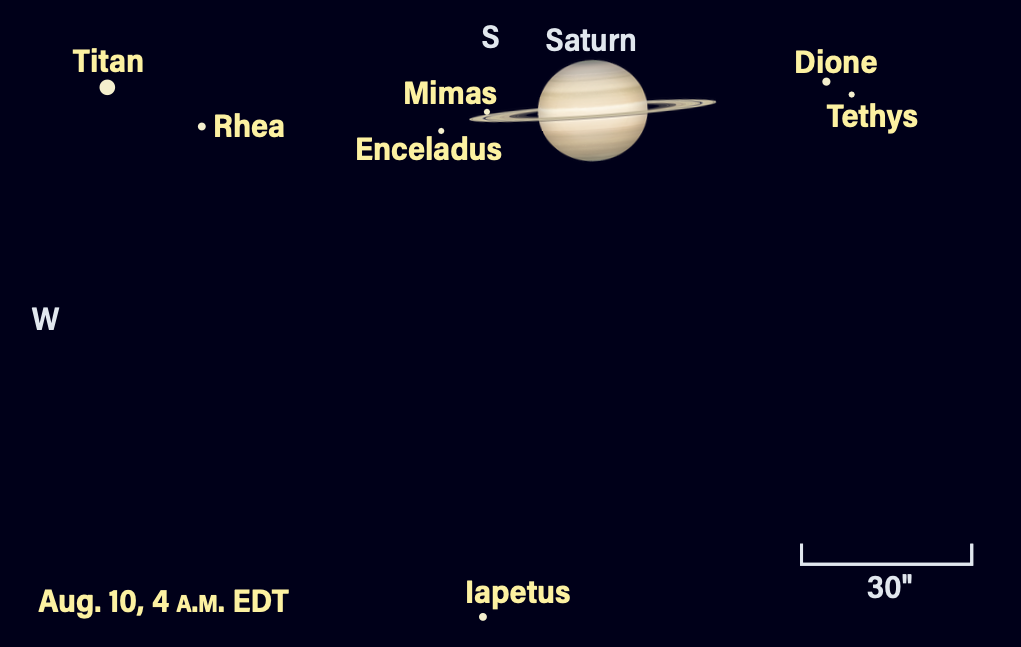
Uranus stands 4.3° south of the Pleiades (M45). The planet moves eastward, with a few similarly bright stars nearby to aid its identification with binoculars.
Uranus shines at magnitude 5.8 in early August, brightening 0.1 magnitude by midmonth. There’s a pair of 6th-magnitude stars due west of the planet: 13 and 14 Tauri. On Aug. 1, Uranus is 2.4° west of 14 Tau. By Aug. 31, the gap increases to 2.9° and Uranus has slowed to almost a halt, about to turn around in a retrograde loop in the first week of September.
Another pair of stars useful to find Uranus is 37 and 39 Tau. Brighter 37 Tau is magnitude 4.4 and stands 4.5° southeast of M45. Uranus and this star form a triangle with M45, with Uranus at the lower right (southwestern) corner. Watch the slowly changing shape of this triangle through binoculars as Uranus moves. A telescope will show the 3.6″-wide, bluish-green-hued disk of the planet under steady sky conditions.
Venus rises around 3 a.m. local daylight time on Aug. 1, shining at magnitude –4. An hour before sunrise it is 20° high in the eastern sky. It maintains a similar altitude for most of the month, crossing Gemini and heading for a spectacular conjunction with Jupiter.
Through a telescope on the 1st, Venus displays a 75-percent-lit disk 14″ across. By the end of August, the phase expands to 84 percent and the disk shrinks to 12″, owing to the planet’s increasing distance from Earth.
The gap between Venus and Jupiter quickly closes. By Aug. 11, they rise 1.2° (two Moon-widths) apart. The conjunction occurs the following morning, the 12th, when they appear 0.9° apart. For a few days on either side of this date, the two planets are a fantastic sight.
There have been 12 conjunctions between these planets in the past decade (including the triple conjunction of 2015), but some occur too close to the Sun to be observed. The next conjunction occurs in June 2026, when they will be 1.6° apart in the evening sky. Their 2027 conjunction is not observable, so the next time they appear this close is November 2028, again in the morning sky.
On the 19th, the crescent Moon joins the scene 7° above Jupiter, which is now magnitude –2. On the 20th, Venus stands 4.5° south of the Moon.
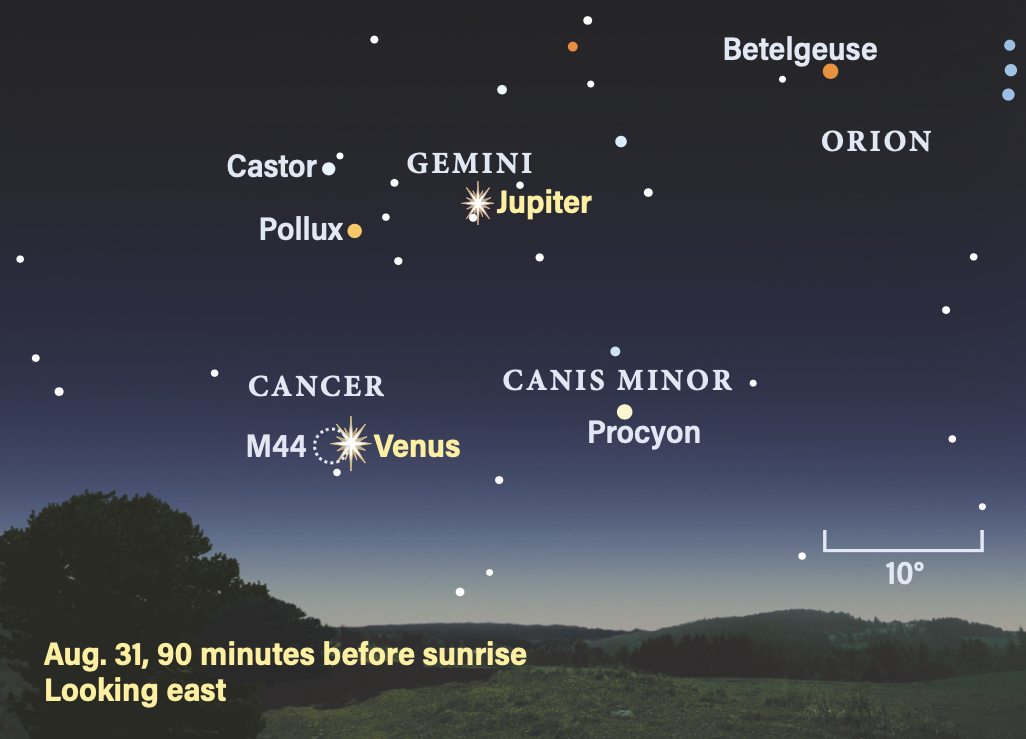
The Beehive Cluster (M44) stands 1.4° northeast of Venus Aug. 31. Venus rises more than two hours before the Sun, so the dazzling meeting of planet and cluster is plain to see. Grab binoculars for the best view.
If you’re an early riser, Jupiter should definitely be on your August observation list. The gas giant rises shortly before 4 a.m. local daylight time on Aug. 1. By Aug. 31, it’s up 90 minutes earlier. Located centrally in Gemini the Twins, Jupiter starts the month at magnitude –1.9. On Aug. 1, it’s just over 10° from Venus.
Jupiter’s low altitude means telescopic views are challenging. However, Jupiter remains visually appealing in twilight and details in its dynamic atmosphere are visible as dusky, delicate swirls. The four Galilean moons track back and forth as they orbit with periods ranging from two to 17 days. In the coming months, many transits across the face of Jupiter will be visible as the planet climbs higher in the sky.
Mercury reached inferior conjunction with the Sun July 31 and moves into the morning sky by the second week of August. On the 12th, it shines at magnitude 1.4, a challenging target.
Eagle-eyed observers might catch Mercury at magnitude 1 on the 14th, 3° high in the eastern sky an hour before sunrise. Jupiter and Venus in Gemini are a good guide for lining up the ecliptic. Draw a line through the duo toward the ground — Mercury lies near that line, close to the horizon in the brightening twilight.
Mercury reaches greatest western elongation on the 19th, standing 19° west of the Sun. It’s now magnitude 0 and 5° high an hour before sunrise — much easier to see. The challenge will be to spot M44 2° due north of Mercury. The dim stars will be best seen from high elevation with a clear eastern horizon.
Look for an attractive crescent Moon nearly 5° north of Mercury on the 21st. At magnitude –0.3, Mercury is quite easy to spot.
Mercury continues to brighten but drops lower each morning. On the last morning of August, it reaches magnitude –1.2 and hangs about 19° below Venus. It’s now clearly visible 45 minutes before sunrise, standing 3° above the eastern horizon.
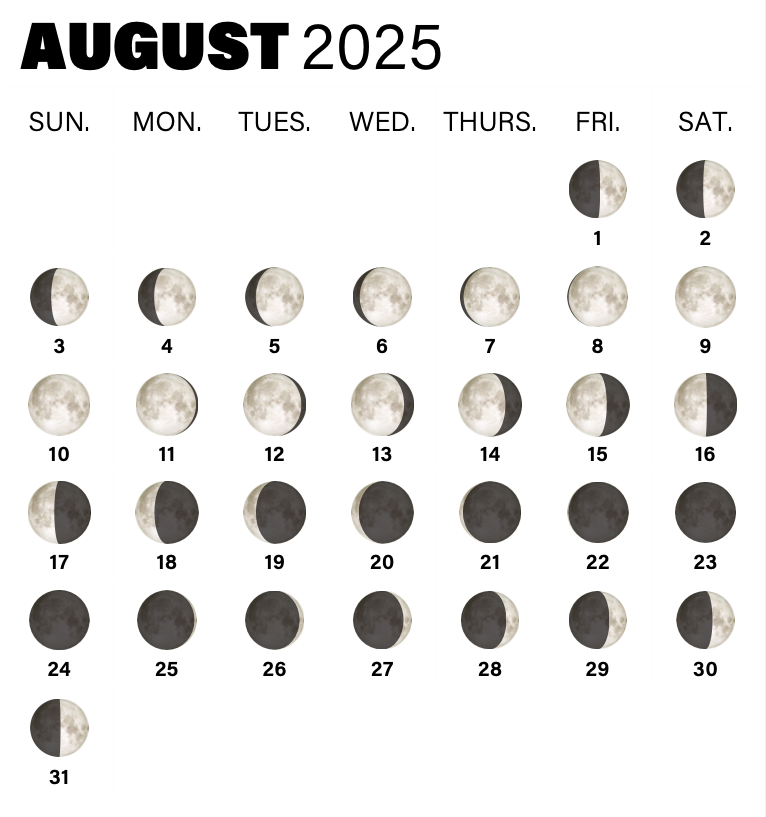
Rising Moon: Wargentin pancake
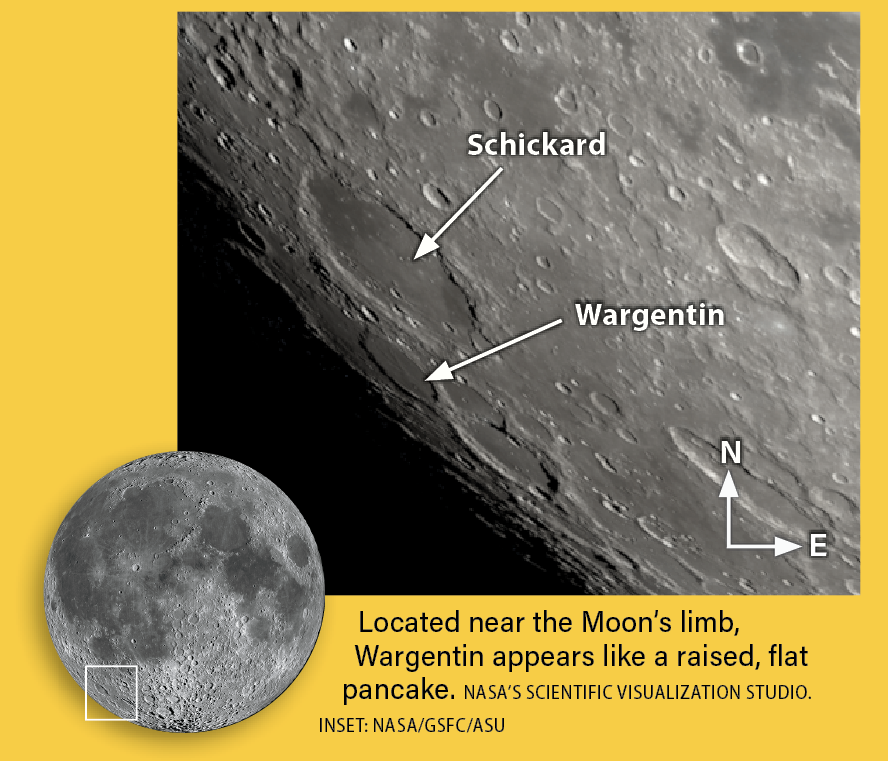
The nearly Full Moon of August sports its own filter. Never climbing higher than Antares, Luna’s light must travel a longer path through Earth’s atmosphere, losing blue wavelengths. Add in the haze from high humidity and it will be quite yellow. Wildfire smoke takes it into eclipselike orange.
On the night of the 6th, after taking in the magnificent ray system of Tycho at low power, grab a shorter eyepiece to zoom into the southwestern limb. The standout shoeprint of Schiller is one guidepost, while one step behind (to the west) lies the large, flat depression of Schickard. Immediately limbward lies the raised oval of Wargentin with a smooth, flat face, just like a pancake!
Astronomers surmise Wargentin began as a normal bowl-shaped crater. Much later, lava welled up through a cracked floor, filling it almost to the brim. Underground compression then forced up wrinkle ridges through the middle. The mild shadow indicates it is a long hill. Confirming its relative youth, the smooth surface is pocked only by two small craters that challenge a 6-inch scope and steady air.
By the 7th, the Sun has risen higher in the lunar sky, wiping out the shadows. The best 3D views are found at the north pole of the Moon from four days before to four days after Full phase, as features cast shadows that seem to exaggerate the relief.
Meteor Watch: A busy morning
A Full Moon Aug. 9 significantly affects the visibility of Perseid meteors. By Aug. 12, the night of the Perseids’ peak, the Moon rises around 10 p.m. local daylight time and remains up the rest of the night, just as the shower’s radiant in Perseus is climbing higher in the sky.
But all is not lost — the Perseid meteor shower carries some of the brightest meteors, which are always visible even with moonlight. You can improve the visibility of fainter meteors by traveling to higher altitudes (above 5,000 feet), where a thinner atmosphere reduces the scattered light of the Moon, rendering the sky darker. Even so, observed rates this year will be well below the advertised peak. Set your expectations at a dozen per hour.
The Perseids are active from July 17 through Aug. 24. The earlier part of the shower occurs under a dark Moon. On Aug. 1, for example, the First Quarter Moon sets around midnight. The radiant reaches a respectable 50° in altitude by 4 a.m. local daylight time. The moonless skies diminish by nearly an hour each day.
The Perseids are associated with Comet 109P/Swift-Tuttle, which last reached perihelion in 1992 and returns again in a century.
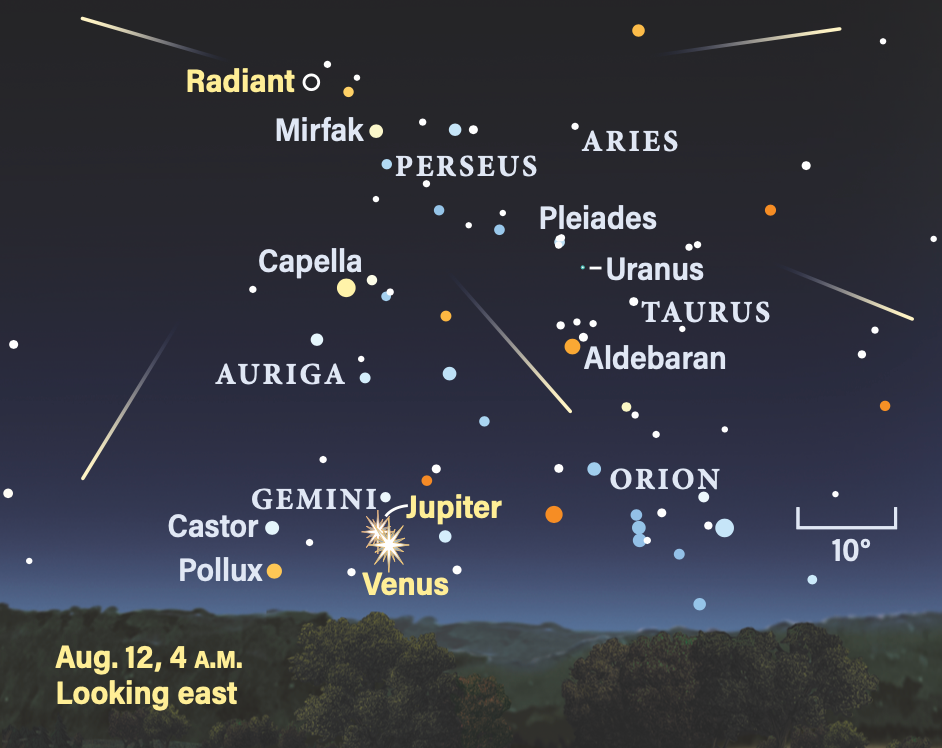
Comet Search: Rising out of the depths
Time deals out smooth averages over the centuries. But on our short human timescales, we see the random absurdity of super-faint comets for three months, followed by November’s clutch of several decent telescopic ones.
Comet C/2024 E1 (Wierzchoś) may reach 4th magnitude in January as it arcs closer to the Sun than Venus. This month, however, it’s a shy 12th-magnitude fuzz high in Hercules. Grab a 10-inch or bigger scope, get yourself under dark country skies, and crank up your navigation skills or turn on your go-to as Wierzchoś slides along the unremarkable boundaries of Hercules, Boötes, and Corona Borealis.
Start with a hit of Hercules’ marvelous M13, then follow up with its distant sibling, globular NGC 6229 at magnitude 9.9, as a warm-up. Power past 150x to get a sense of small, faint targets. On your way to the fringe, claim the faint planetary NGC 6058 — a nebula half the apparent size of Jupiter. Compare its structure and brightness to the comet.
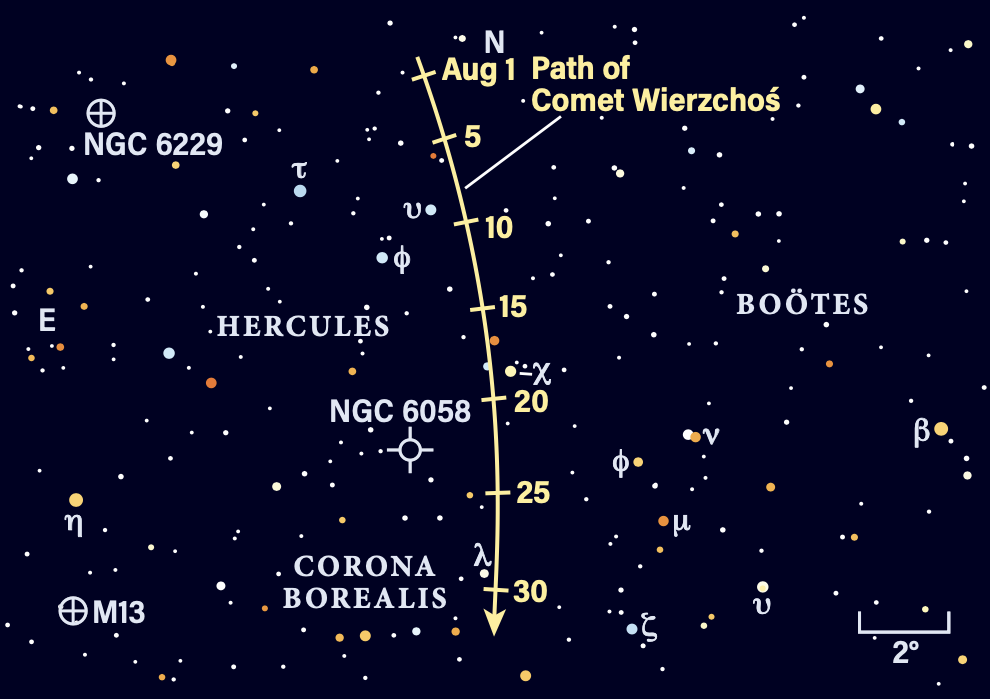
Locating Asteroids: Not hanging in the balance
Splitting the uprights of the celestial Scales — unaided-eye stars Alpha (α) and Beta (β) Librae — binocular-easy asteroid 4 Vesta glides amongst standout star patterns as well as empty fields. Its gradual slump from magnitude 7.2 to 7.6 shouldn’t challenge you much from the suburbs.
To track our target, sketch in a logbook the arc of five stars, starting with the lovely double star Alpha Lib (Zubenelgenubi). Every couple of nights add Vesta’s dot, leaving enough space on the left to capture two weeks of movement. Repeat for the last week of August as Vesta moves from Omicron (ο) Lib toward the quad of Zetas (ζ). The best night to see displacement at medium power in a scope is on the 9th. Vesta forms the heel of a hockey stick shape that approaches a right angle over two to three hours.
Asteroids on occasion pass in front of stars in an occultation. Visit the International Occultation Timing Association at www.lunar-occultations.com/iota/iotandx.htm and explore the links under “Asteroid Occultation Information” to find events for your location. You may already have most of the gear needed to capture science-worthy measurements. If not, it’s still cool to watch a star wink out for a second.
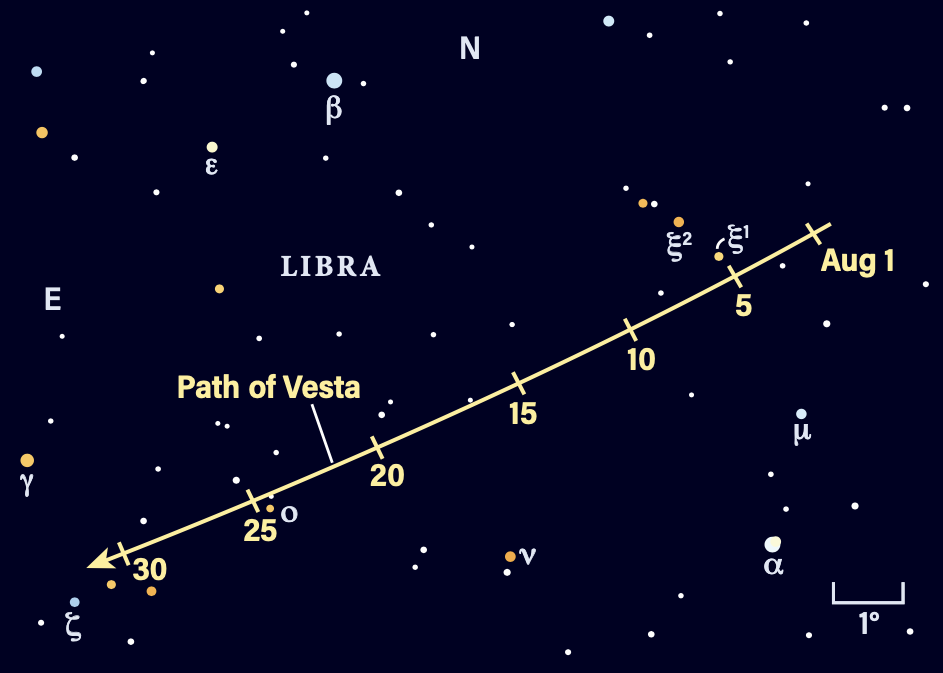
Star Dome
The map below portrays the sky as seen near 35° north latitude. Located inside the border are the cardinal directions and their intermediate points. To find stars, hold the map overhead and orient it so one of the labels matches the direction you’re facing. The stars above the map’s horizon now match what’s in the sky.
The all-sky map shows how the sky looks at:
11 p.m. August 1
10 p.m. August 15
9 p.m. August 31
Planets are shown at midmonth



